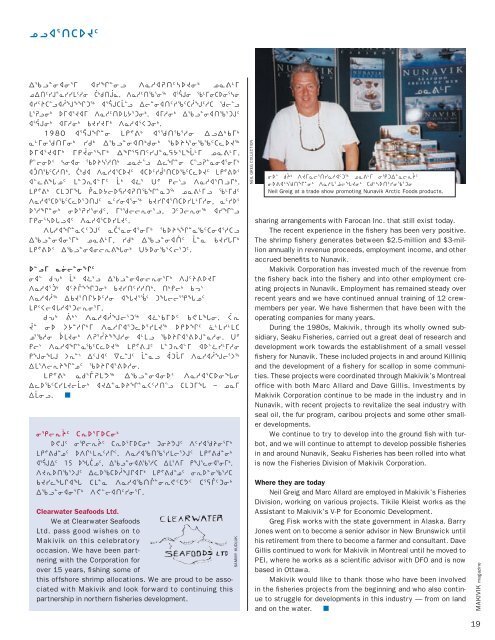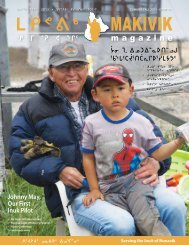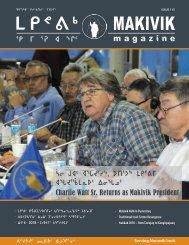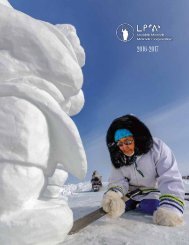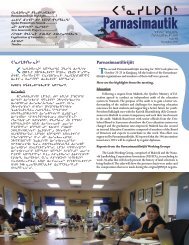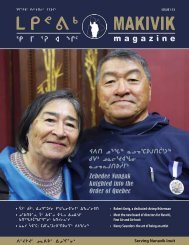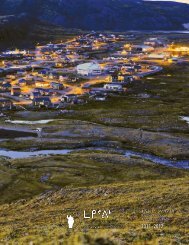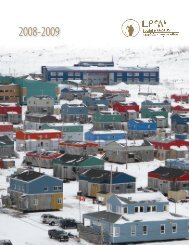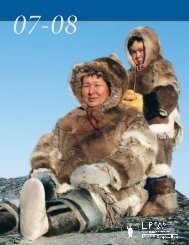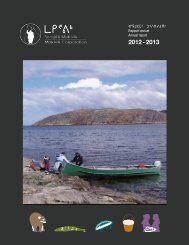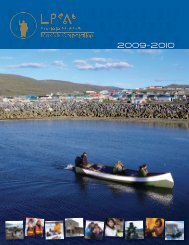Makivik Magazine Issue 65
Create successful ePaper yourself
Turn your PDF publications into a flip-book with our unique Google optimized e-Paper software.
cspZhx3[u4 eu3Di6<br />
Research Observations<br />
x?t9l b9omi4 x3ÇAi4<br />
cspn3ico3SA5<br />
x9MbsJ5 ᐲ9 gw0j5, kN[s2 cspZhx3[zb<br />
x9M[zi4 grjx5typj5<br />
Twenty-five Years<br />
of Research<br />
By Bill Doidge, Director,<br />
Nunavik Research Centre<br />
mr{[s2 tudtzb cspn3[zb WQx3[Qym/z stEx3[cD8NS6<br />
Ö5hmi kNÌChx3iu4 xqctŒZhx3ic3tlQ5 vg5pctŒ8if5<br />
(NQIA) ho kwbq8Nt9lQ5 kN1axi4 xg3bsJcc5bi3m5<br />
x9Mbst5yAts5ht4 kNs2 xg3bs§aAtq8i4.<br />
ÔyW x1µ6 Ggrjx5typso3g6 kbsyoD8Ngi4<br />
W[5nsA8Ngi4 W?9oxt5y[s2 WA5p[zk5H,<br />
ᐲ9 rx72, lᕇ8 SD4 xuh7mᕇ9l<br />
xyq5 kw5ynstQoMs3ymJ5 mr{[f5<br />
cspm/sAtQ§Eo3bqi4 WD3[sA8Ng5<br />
grym/sAtq8k5 x7ml kNs2 xg3bsizk5<br />
cspn3iEym/zk5.<br />
wkw5 fÑ4 b3Czius5 gryAmMs3ym7uJ5<br />
sc9lfxW5bsQxo8i4 x?tu4 cspn3bs-<br />
Jco3m5 ƒ1j5 wfmosDt5ni4 W?9oxtbsJco3tlA.<br />
>c9lˆius5> cspn3tq8i4<br />
WNh5tÌE/sJo[i6 WNhxctc3ixt9lQ5<br />
mò5ti4 grym/ui4 sçc5bt9lQ5<br />
w2WQ/cDm5ht9l bm4fx wkw5<br />
grym/q5 xg3tbs5yxicClx3m¯b<br />
grÌ3bsJcExcogx3m5 bm5hjz<br />
W?9oxt5yZhx3ij5 kN[7u. Ömzi5,<br />
nNymJ5 xy5pym§aoClx3tlQ5 ryxi<br />
bm4fx kwbsmJ5 ho g1z[Q/sq8Ng5<br />
s9lu kN[s2 cspn3[zb x9M[zk5.<br />
cspn3[s2 WNhx3[z W?9oxic3ymo3g6<br />
x5ybsmiztA9l WNhxD8NiztA9l. ƒ4Jx2 cspZhx3[zb<br />
x9M[z kwbsQx1zymJ6 s9lu nN1ax[Q/s§ao3gu4<br />
ƒ4Jxu, ryxi !(&*–at9lA kNo8k5 yr©os3[sMs3ymJ6<br />
w9loxE/sQxzg[is5hi<br />
xuEvus5 sNb3tq5 ho<br />
bµî5tlQ5.<br />
WNhxEx1zc5bo3tlQ5<br />
kN1axosExcc5bymJ5,<br />
x8igxa§i9l cspn3ic3ht4,<br />
ƒ4Jxul wcl8i4 cspn3ic3ht4<br />
kw5yht9l WD[sA8Ngk5<br />
grym/sAygcq8i4 cEbs/<br />
ü5tyAti4. !(*^–u ƒ4Jxu<br />
cspn3[4 ªMs3ymJ5 douÅcsts2<br />
kNzk5 Wb dx+m8<br />
WNhx3[QQx1zym/zk5. csp-<br />
Zhx3[4 i8isoMs3ymJ6 Övi<br />
w9lu x9M[5Ìy7uhi c9lt4<br />
s3hxl8ix[zb w9ldtzi<br />
Gyx9f5 kN4fÔos3[ziH.<br />
t X l v c 3 i z k 9 l<br />
s[Z3gxWs5hi ho ᐋo4+ fxb<br />
sdà8iixMs3ymK6 g5gu4<br />
r[mJ[i3u4 Ö5hmi !(*$-at9lA<br />
A young Alix Gordon weighing one of the<br />
drowned caribou back in 1984.<br />
ÏixW+vs2 ƒzi g5gw5 xyD3i[iq8i4 nl7mãi6 !(*$at9lA<br />
wvJ3y/sQxcMs3ymK6 douÅo7jl xuhxl8kl<br />
wk8k5, g5gw5 wµi gdymJ6 sk3ic3ym7mb !),))) szÌi.<br />
The Caniapiscau River caribou disaster cleanup in 1884 required<br />
the use of a helicopter and a lot of manpower to sling the more than<br />
10,000 drowned animals away.<br />
Research at <strong>Makivik</strong> Corporation can trace its roots back<br />
to the times of land-claims negotiations during the NQIA days<br />
when maps were used to document land-use. Jusipi Agma<br />
(now head of our Renewable Resource<br />
Development Depar tment), Bill Kemp,<br />
Lorraine Brooke and many others soon<br />
established <strong>Makivik</strong>’s reputation in<br />
Traditional Ecological Knowledge (TEK)<br />
and land-use studies.<br />
The Inuit of nor thern Québec also<br />
wanted to understand the technical terms<br />
used in the environmental studies undertaken<br />
for the hydro-electricty development<br />
project. “Southern” researchers were<br />
hired to work closely with the hunters to<br />
share knowledge and to make sure that<br />
Inuit knowledge was incorporated in any<br />
decision-making concerning development<br />
in Nunavik. Since then, technology has<br />
changed, but this basic premise remains<br />
MAKIVIK RESEARCH<br />
as the cornerstone of the present Nunavik<br />
Research Centre.<br />
The Research Depar tment evolved<br />
in name and grew in capabilities. The<br />
Kuujjuaq Research Centre was first established<br />
in what is now Kuujjuaq’s craft’s workshop, but in 1978<br />
it had been the municipal skidoo repair shop which dated back<br />
to the American airbase days.<br />
Early work entailed mapping,<br />
har vest studies, the<br />
Koksoak Fish Study and establishing<br />
the traditional ecological<br />
knowledge data base. In 1986,<br />
the Kuujjuaq Research Centre<br />
moved to the former HeliQuebec<br />
base of Peter Horseman fame. It<br />
soon outgrew that building and<br />
took up space in the back of<br />
the Halutik Fuels building (the<br />
Shell garage). Bad fumes and<br />
a need for lab space convinced<br />
<strong>Makivik</strong>’s executives that a new<br />
FILE PHOTO<br />
facility was needed. The old<br />
weather station, T-1, which was<br />
owned by Nayumivik Landholding<br />
Corporation, was purchased and<br />
MAKIVIK magazine<br />
21


